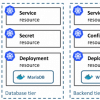docker
 |
Running a Data Pipeline with Apache Beam Golang SDK on Docker This article explains how to run a data pipeline using Apache Beam Golang SDK with Docker. It provides a step-by-step guide on how to install Docker, Golang, and Apache Beam Go SDK, as well as how to run the Wordcount example. |
|
 |
Choosing a Linux Distribution for Docker Containers In the Linux operating system, each Docker container does not use a complete operating system kernel; multiple Docker containers can share the same one. Which Linux distribution should you use as the host? Let’s look at the factors that govern the choice of a host OS, as well as the Linux to run within a Docker container. |
|
|
|
Exploring Containers: Creating a Dockerfile Docker containers are launched using Docker images, which are built from layers of Dockerfiles. A Dockerfile is a text document that contains all the commands or instructions to create, copy, and run an image. Let’s look at what goes into creating a Dockerfile, which could be used to build a runnable Docker image. |
|
 |
Using More Advanced Kubernetes Controllers Kubernetes is an object-oriented framework for orchestration of Docker containers. While running basic Kubernetes objects like pods and services is essential to all Kubernetes applications, what controller to use should be based on several factors. Let’s explore some advanced controller options for additional features. |
|
 |
Using Basic Kubernetes Objects Kubernetes is an object-oriented framework for orchestration of Docker containers. The Kubernetes API supports several different types of objects and provides schemas for all the objects it supports. While there are many options for different features, let’s look at some of the main Kubernetes objects and their uses. |
|
 |
Choosing a Container Orchestration Platform with Docker Docker is the de facto container platform, supporting the microservices architecture for deploying loosely coupled applications. However, Docker supports several container orchestration platforms—which should you choose? Let’s look at some of the main platforms: Kubernetes, Docker Swarm, OpenShift, Mesos, and CFCR. |
|
 |
Using a Multibranch Jenkins Pipeline with Docker Typically, code for a Docker image is developed using multiple GitHub branches, with each branch being the code for a single Docker image tag. However, having to create and run a Jenkins pipeline for each GitHub branch can be cumbersome. Try a multibranch pipeline to integrate multiple GitHub branches simultaneously. |
|
 |
Using Kubernetes Helm Charts for Increased DevOps Collaboration A Docker image is usually designed for a baseline functionality and can then be customized. However, customized resource definitions are typically not shared among other users who might have a similar application requirement. Here’s where Helm charts for Kubernetes can help reduce rework and increase collaboration. |

